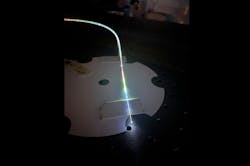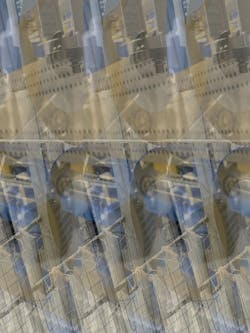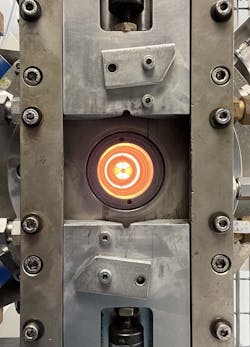Microstructured optical fibers for quantum computing?
To unleash the full power of quantum computing, an international team of researchers led by physicists at the University of Bath’s Centre for Photonics and Photonic Materials in the U.K. are designing specialty fibers with a microstructured core, which consists of a complex pattern of air pockets running along the entire length of the fiber (see video). Its air pocket patterns enable the researchers to manipulate the properties of light within the fiber to create entangled pairs of photons, change their color, or trap individual atoms inside the fibers.
Why the need for specialty fibers? Unfortunately, optical fiber networks designed for telecommunications today transmit light at wavelengths not compatible with the operational wavelengths of quantum computing’s light-based silicon-photon sources, qubits, and active optical components. And the solid cores of these optical fibers are likely suboptimal for quantum technologies as well.
“Optical fibers offer the prospect of creating fully integrated quantum devices, without the need for interfacing and aligning with free-space components,” says Dr. Kristina Rusimova, a lecturer in the Department of Physics at Bath. “This is promising for reducing the losses of such devices, which could be a major breakthrough for the field—retaining the single photon for long enough to be interacted with another single photon is an underpinning challenge for the technology.”
Beyond this, fibers and fiber-based devices can readily be integrated into existing optical fiber networks. Microstructured optical fibers are extremely versatile and offer a flexible solution across a broad range of applications. They are used as both sources, communication channels, sensors, and active optical components.
A hollow-core fiber design
Hollow-core fibers are more challenging to manufacture than solid-core fibers due to their thin-wall glass microstructures that serve as their cladding. “These thin structures can be difficult to control during the drawing process in a furnace, where large glass structures are transformed into optical fibers,” says Dr. Kerrianne Harrington, a postdoctoral physics researcher at Bath.
But recent advances in fabrication techniques and structural design enabled hollow-core fibers to achieve lower loss than traditional telecommunication fibers.
“Ongoing improvements are expanding the performance of such fibers across a broad range of wavelengths, which makes them suitable for optical quantum systems,” Harrington adds. “Hollow-core fibers can be used as long-distance communication channels to reduce the need for quantum repeaters; they also offer low latency, low optical nonlinearity, and can be used for vessels for atom-based quantum devices—enabling longer interaction lengths and increased optical depth, tighter confinement, and easy integration with other fibers.”
Photonic crystal fibers also offer tunable nonlinearity, which Harrington points out is useful in quantum resource state generation over a range of operational wavelengths.
Fiber fabrication at Bath
The fiber fabrication facility at Bath is “the only one within the U.K. fully dedicated to the development and fabrication of microstructured optical fibers of this kind,” says Rusimova. “Key benefits to society include the prospect of ultrasecure communications and quantum computers that offer unparalleled computational power and can simulate the complex molecules involved in the fabrication of new drugs and materials.”
Major challenges ahead for the field include achieving low-loss integration between fiber-based components and on-chip quantum devices, as well as reliably trapping atomic vapors inside optical fibers without the need for a vacuum system attached to them.
Sources of noise, like Raman scattering, are also a big challenge for most quantum applications. And it will be necessary to achieve a consistent yield and overcome microbends and mechanical stress within hollow-core fibers, which currently prevent their use for long-distance communications.
Frequency conversion and generation of multiplexed single photons
The most interesting applications for their hollow-core fibers, the team says, are frequency conversion and to generate multiplexed single photons. The former allows them to interface components of quantum networks that operate at different wavelengths to one another, such as sources, memories, or transmission lines.
Significantly, the work at Bath marks the first demonstration of a fiber that can perform quantum frequency conversion over a broad range of wavelengths. And multiplexed state generation overcomes the inherently probabilistic nature of quantum sources to enable a source with high enough efficiency for quantum applications.
Microstructured optical fibers ahead
Optical fibers can be integral to any component of a quantum device and have many applications ranging from secure communications, quantum computing, accurate timing, and distributed sensing. “Recent progress in these areas has been quite rapid, with demonstrations of quantum entanglement distribution on city-scale distances, and we think these technologies will be part of our lives in the not-too-distant future,” says Dr. Alex Davis, an ESPRC Quantum Career Acceleration Fellow at Bath.
“We anticipate that in the near-term these systems will play a key role in future quantum networks and other quantum technologies,” says Davis. “Especially exciting is the prospect of using these fibers to generate exotic new quantum states to use as a resource for quantum computing, to connect photonic architectures that span a range of wavelengths, and to combine the unique waveguiding properties of fiber with quantum interactions enabled by atomic ensembles. To get there, we need to overcome key challenges around integration, loss, noise, and yield.”
FURTHER READING
C. McGarry, K. Harrington, A. O. C. Davis, P. J. Mosley, and K. R. Rusimova, APL Quantum, 1, 030901 (2024); https://doi.org/10.1063/5.0211055.
About the Author
Sally Cole Johnson
Editor in Chief
Sally Cole Johnson, Laser Focus World’s editor in chief, is a science and technology journalist who specializes in physics and semiconductors.



